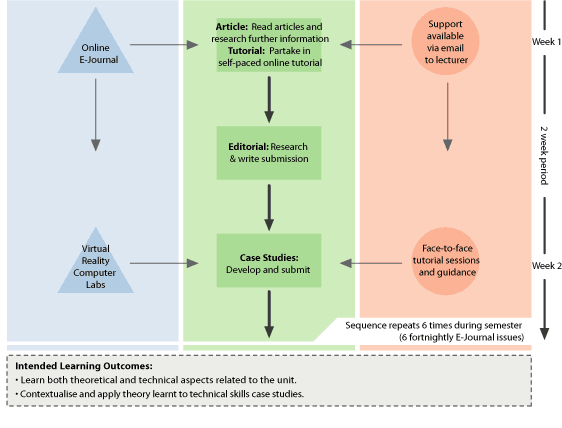|
WHAT THE STUDENTS DO
Each fortnightly E-Journal issue comprises a set of issue-specific
activities. It is recommended that Article and online Tutorial
activities are carried out in Week 1 of the fortnight, and
Editorial and Case Studies carried out in Week 2, along with
participation in the face-to-face tutorial sessions.
Fortnightly Period:
Week 1
Article: Students read article summaries
on each issue front-page matrix plus full PDF articles. Students
also research further information via links provided.
Tutorial: Students undertake the online
tutorial to gain technical skills in the relevant technology
for application in the case studies; e.g. utilising virtual
reality software: Cosmo World.
Week 2
Editorial: Students research topical question
posed in Editorial (in matrix on front page of issue) and
contribute reflective submissions to the Editorial page of
site.
Case Studies: Students work either individually
or in small groups to develop their own unique case study
projects, integrating theoretical knowledge from Articles/Editorial
and practical skills gained from both online and face-to-face
tutorials.
Works-in-progress are submitted to the Case Studies page
of the relevant E-Journal issue, along with reflective comments
and insights.
Face-to-face tutorials are held on a fortnightly
basis, to provide one-on-one support for ongoing case study
projects.
SIGNIFICANCE OF ORDER
As BNB011 is an introductory, cross-discipline unit, it has
been designed with linear progression across issues, to ensure
a common knowledge/skill base. It is therefore recommended
to follow this linear progression within this unit, although
there are choices available in how to undertake the activities
within each issue.
Within the BNB011 fortnightly E-Journal issues there is choice
available between timing of undertaking the week 1 activities;
e.g. it is up to the student on whether to start with the
theoretical component, i.e. articles or the technical component,
i.e. online Tutorials. In the week 2 activities it is recommended
to complete the Editorial submissions before the case studies
in order to inform the case study developments with theoretical
insights.
Once issues have been completed, the student is able to
obtain insights about their own and colleagues' developments
from both a horizontal perspective across issues, as well
as indepth perspective in to each specific issue.
The E-Journal methodology can also be applied to contexts
without linear progression, where each issue may be a discreet
entity to be undertaken at the discretion of the student.
CRITICAL ACTIVITIES
For a student with no prior knowledge in this area, each of
the activities is considered critical to allow for full integration
of theory and practice. However, if a student has prior technical
experience, it may be possible to circumvent the online tutorial,
or the Articles in the case of prior theoretical insight.
The Editorial and Case Study submissions would still be mandatory
in all circumstances, to form a part of the continuous assessment
process.
|
